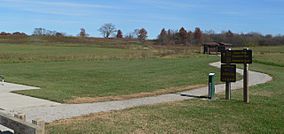Osage Village State Historic Site facts for kids
Quick facts for kids Osage Village State Historic Site |
|
|---|---|

The site's interpretive trail
|
|
| Location | Vernon, Missouri, United States |
| Area | 100 acres (40 ha) |
| Established | 1984 |
| Operator | Missouri Department of Natural Resources |
| Website | Osage Village State Historic Site |
The Osage Village State Historic Site is a special place in Vernon County, Missouri. It's managed by the Missouri Department of Natural Resources. This historic site protects the remains of a very important Osage village. Long ago, this village was home to 2,000 to 3,000 people living in about 200 lodges. This site is so important that it was named a National Historic Landmark in 1964.
History of the Osage Village
The Osage Indians were first written about in 1673. Explorers Louis Joliet and Jacques Marquette recorded their presence. At its largest, the Osage territory was huge. It covered parts of what is now southern Missouri, Arkansas, eastern Kansas, and Oklahoma.
Between the years 1700 and 1775, a large group of Osage people lived in a village. This village was located on a high, open hilltop. It was close to the Osage River valley. This area is now preserved as the Osage Village State Historic Site. It was made a National Historic Landmark because of the Osage people's importance in this region. The village was also very large for its time.
Life in the Osage Village
At its busiest, the village had about 200 lodges. These lodges were home to 2,000 to 3,000 people. Scientists have dug up the site to learn more. They found that the homes were shaped like rectangles.
Archaeologists have also found many items. These include pottery, weapons, and tools. These artifacts help us understand what daily life was like for the villagers. The men in the village hunted animals for food and furs. They traded these furs with Europeans. In return, they received guns and other goods.
The women grew and prepared crops. They also processed the hunted animals and their hides. This helped them make food, clothing, and tools for everyone. In the late 1700s and early 1800s, the Osage Indians were very important in trade. They handled more than half of all the fur trade with Europeans along the Missouri River.
Changes for the Osage People
In 1804, the United States government took control of the Louisiana Purchase territory. This new land encouraged European Americans to move into the area. The U.S. government made agreements, called treaties, with the Osage. These treaties asked the Osage to give up their land to the U.S.
Because of these treaties, the Osage Indians slowly had to move. They were eventually forced to go to a special area called a reservation. This reservation was in what was then called Indian Territory. Today, that area is known as Oklahoma.




